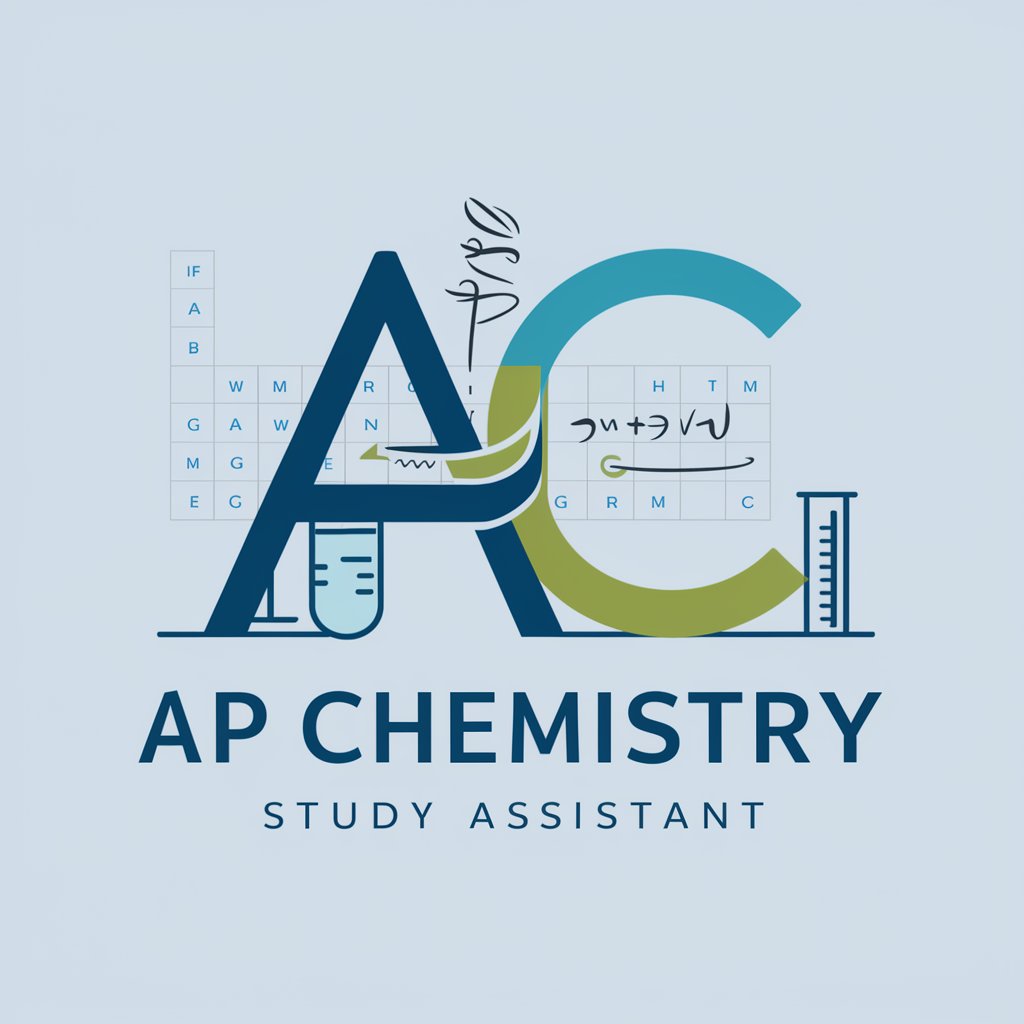AP Chemistry - AP Chemistry Assistance

Welcome to AP Chemistry! Let's explore the world of chemistry together.
Master Chemistry with AI-Powered Guidance
Explain the significance of the periodic table in chemistry.
Describe the process of balancing chemical equations.
How does the ideal gas law apply to real-world scenarios?
What is the role of catalysts in chemical reactions?
Get Embed Code
Introduction to AP Chemistry
AP Chemistry is an advanced placement course designed for high school students as a gateway to earn college-level credit. The course is structured to provide students with a foundational understanding of chemical principles and practices. Through a blend of theoretical knowledge and practical experiments, AP Chemistry aims to enhance students' analytical, problem-solving, and laboratory skills. For instance, students explore atomic structure, chemical bonding, thermodynamics, kinetics, and equilibrium, applying these concepts in laboratory experiments to synthesize compounds, analyze reaction rates, and determine chemical equilibria. Powered by ChatGPT-4o。

Main Functions of AP Chemistry
Conceptual Understanding and Problem Solving
Example
Students learn to apply the principles of stoichiometry to determine the composition of compounds and reaction yields.
Scenario
In a real-world scenario, this could involve calculating the amount of reactants needed to produce a desired quantity of product in an industrial chemical process.
Laboratory Skills Development
Example
Conducting titration experiments to determine the concentration of an unknown solution.
Scenario
This is akin to a quality control chemist analyzing the concentration of active ingredients in pharmaceutical products.
Analytical Thinking and Data Interpretation
Example
Interpreting molecular spectra to identify chemical substances.
Scenario
Similar to a forensic chemist analyzing sample residues to identify substances present at a crime scene.
Ideal Users of AP Chemistry Services
High School Students
Students seeking to challenge themselves academically and earn college credit while still in high school, preparing for STEM fields in higher education.
Educators and Teachers
High school chemistry teachers looking for a structured curriculum to provide advanced chemistry education, fostering critical thinking and practical skills among students.

How to Use AP Chemistry Guide
1
Begin by exploring yeschat.ai for an accessible trial, requiring no sign-up or ChatGPT Plus subscription.
2
Familiarize yourself with the AP Chemistry course content by reviewing chapters on atomic structure, chemical reactions, thermodynamics, and equilibrium.
3
Use the tool to clarify complex chemistry concepts, solve chemical equations, and understand experiment outcomes.
4
Practice with AP exam preparation questions provided by the tool to assess your readiness.
5
Regularly check for updates on additional resources and advanced features to enhance your study experience.
Try other advanced and practical GPTs
AP Precalculus
Unlock Math Mastery with AI

AP English Essay Scorer
Elevate Your Essay with AI-Powered Insights

AP English
Master Literature with AI

Statistics Tutor with R, Python and SPSS
AI-powered tool for statistical analysis in R, Python, and SPSS

Business Statistics Calculator
AI-powered business statistics made easy
Dating App Chat Expert
AI-powered witty and confident chat replies

워렌버핏의 지혜
Explore Buffett’s investing wisdom, powered by AI.

워크독스 Workdoxs 이메일
AI-powered language translation for emails

Artwork Curator:[미술평론]
AI-powered artwork review for artists
![Artwork Curator:[미술평론]](https://files.oaiusercontent.com/file-5xFc59l6tvsBZD9WZvqOalsz?se=2124-01-17T23%3A25%3A56Z&sp=r&sv=2021-08-06&sr=b&rscc=max-age%3D1209600%2C%20immutable&rscd=attachment%3B%20filename%3D_87d98940-a2b0-443d-9695-77440cbdac4c.jpg&sig=GdBR7hjH%2BpZ4f%2BXi2em7jIfIw7EBMR2M2sKbbimOago%3D)
비주얼 크리에이터
AI-driven Creativity at Your Fingertips

창의적 디자이너
Empowering creativity through AI

이준호 의사 - 치아(치주염) 전문
AI-Powered Periodontal Health Advisor

AP Chemistry Guide FAQs
What topics can AP Chemistry Guide help me with?
The guide covers a wide range of topics including atomic structure, molecular bonding, chemical reactions, kinetics, thermodynamics, equilibrium, and acids and bases, aimed at supporting your AP Chemistry exam preparation.
Can this tool help me solve chemical equations?
Yes, the AP Chemistry Guide is designed to assist in solving chemical equations by providing step-by-step explanations and relevant chemical principles.
Is the AP Chemistry Guide suitable for beginners?
Absolutely. The guide offers comprehensive explanations that are helpful for beginners to grasp fundamental concepts, as well as for advanced learners aiming to deepen their understanding.
How often should I use this tool for effective AP exam preparation?
Regular usage, such as weekly sessions to review concepts and solve practice questions, is recommended to reinforce learning and effectively prepare for the AP exam.
Can AP Chemistry Guide help with lab experiment concepts?
Yes, the tool provides insights into common lab experiments in the AP Chemistry curriculum, explaining the underlying chemical principles and expected outcomes.
